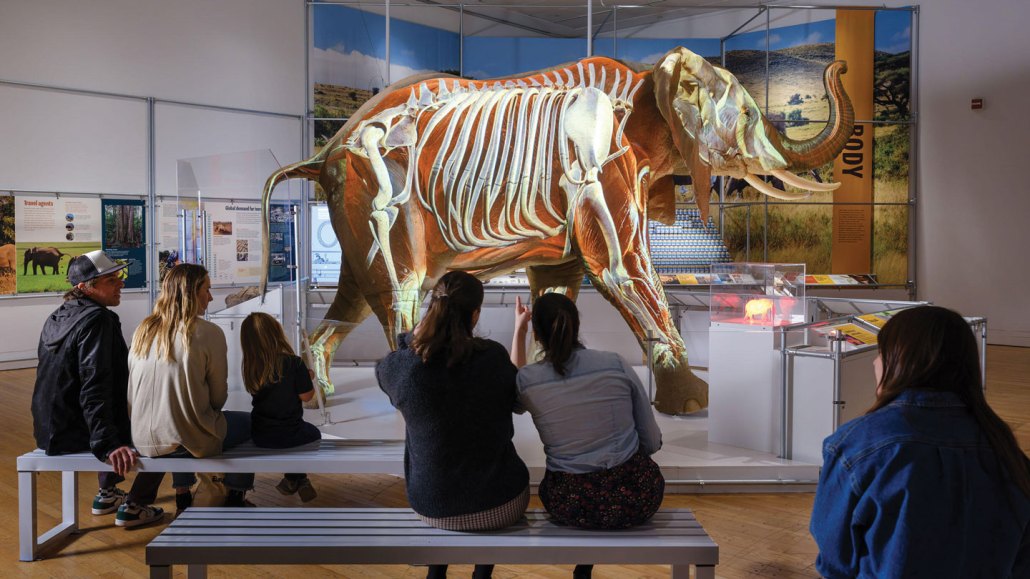
An African elephant’s skeleton and muscles are projected onto a life-size model in an exhibit that highlights new science on proboscideans.
Alvaro Keding/© AMNH
- More than 2 years ago
For millions of years, over a dozen species of proboscideans, the group that includes mammoths, mastodons and elephants, roamed landscapes as varied as Arctic tundra and African savannas. Then, around 11,700 years ago, as the last ice age waned and human hunting picked up, this number dwindled to just three: the Asian elephant, the African forest elephant and the African savanna elephant — all of which are now endangered.
Losing elephants comes with a far-reaching and underappreciated impact, warns “The Secret World of Elephants.” The exhibit, now on display at the American Museum of Natural History in New York City, explores that impact, as well as what modern science is revealing about elephant minds and bodies.
As ecosystem engineers, modern elephants transform their environments. Because these herbivores are so big, they eat a lot, poop a lot and travel far to graze, dispersing mounds of viable seeds far and wide. The beasts also trample fields, making room for a diversity of plants, and dig enormous water holes that other animals use too. In North American grasslands, the departure of mammoths and other large herbivores homogenized the land, covering rich landscapes with slow-growing plants and invasive weeds (SN: 11/24/18, p. 22), says curator Ross MacPhee, a mammalogist at the museum.
The loss is cultural too. Though the exhibit is small, it’s packed with displays focusing on how elephants shape — or have been incorporated into — our lives. The animals appear in early cave drawings and in religious stories. (This connection hasn’t always benefited elephants, though, as humans have trained them as war steeds and circus performers.)
The exhibit aims to rekindle our connection with elephants by emphasizing that they, too, are smart and social creatures. They can recognize themselves in mirrors, a potential sign of self-awareness, and can use tools. Videos in the exhibit show elephants playing with and comforting one another. By pressing buttons on an interactive board, visitors can also hear calls that appear to convey fear, affection and annoyance.
Much of the exhibit’s appeal comes from its exploration of how elephants differ from us. The animals, for instance, hear not just with their ears but also with their feet, picking up on the subtle vibrations of the ground beneath them. They also have a superior sense of smell, with more smell receptor genes than even dogs. And it’s hard to fathom that the average adult male African elephant consumes some 150 kilograms of food every day.
It’s amazing to see all that researchers can glean from what the animals leave behind. Chemical analyses of tusks, for instance, can reveal what an elephant ate and where it traveled during its lifetime. DNA samples, meanwhile, show unexpected evolutionary connections between elephants and animals that look nothing like them, including aardvarks and tenrecs.
By including grand visuals and tactile elements, the exhibit is appealing to visitors of all ages. During my visit, a group of schoolchildren admired a life-size model of an elephant and stroked a replica of the creature’s wrinkly skin. I ran my fingers along the ridges of a fossilized mammoth tooth and better understood how they served as a tool for grinding up tough grasses.
Overall, the exhibit sparks both curiosity and alarm. “If we don’t act quickly,” a sign states, “elephants could be gone before we ever truly get to know them.” The exhibit’s curators hope that “The Secret Lives of Elephants” inspires visitors to help stave off the animals’ extinction.
Supporting local nonprofits that protect elephant habitats is one way individuals can help, the exhibit suggests. Another is to abstain from purchasing ivory or other elephant products. Although it is illegal to sell ivory in the United States, the European Union and China, a thriving black market fuels rampant poaching, on such a scale that some elephants may be evolving to lose their characteristic tusks (SN: 11/20/21, p. 15).






